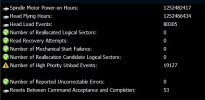Situation
What i have in mind
EDIT:
uh.. I'll just backup both HDD, to be extra safe.
Seagate has been contacted with SMART info of the HDD, and they say i can RMA it to them (like.. in less than 15 minutes i emailed them, they contacted me lol. so fast!). WD still hasn't responded.
- I have 8 HDDs spread into 4 blocks/groups.
- 1 group (containing 2 HDDs), make clicking and spin-up-spin-down sound for like 4x before it stabilizes and operating normally.
What i have in mind
- is to power off the HDD group that's making problematic sounds
- unplug 1 HDD and power on. If its no longer clicking, then the one i unplugged is the problematic one.
- plug the problematic HDD again and do full backup.
EDIT:
uh.. I'll just backup both HDD, to be extra safe.
Seagate has been contacted with SMART info of the HDD, and they say i can RMA it to them (like.. in less than 15 minutes i emailed them, they contacted me lol. so fast!). WD still hasn't responded.
Last edited:


